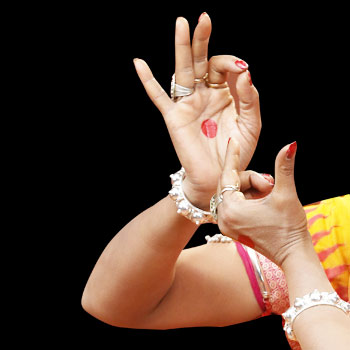
Hand Gestures
NatyaSutraOnline is an attempt to permanently preserve the rich classical dance and music heritage of India. Our dream is to provide 24/7 online access to personalized lectures, tutorials, dance classes, and performances of all Indian classical dance forms.
The dance form Kathak draws its name from the word ‘Katha’, which means a ‘story’. Kathak dancers are ancient storytellers who bring the past to life. They take our fables and dreams and represent it in a colorful way on stage. They represent the vanguard that preserves and cultivates our heritage, passed down via moves that have survived for thousands of years.
History of Kathak
The earliest accounts of Kathak appear to be from 430 B.C.E. The original performers were called Kathakas, who were a nomadic tribe of artisans. They would travel from village to village, serenading the local populace with famous and interesting stories from Indian Mythology. The Sage Bharata included many of the fundamental traits of Kathak in his legendary Natyashastra, the fifth Veda. Over the course of time, Kathak would evolve from a roadshow to court performances to eventually turning in an art form performed on stage.
Styles of Kathak
A traditional performance begins with a Vandana. This sacred invocation is the artisan’s opportunity to express gratitude to the heavens and the teachers who have guided them to this point. This is followed by either the Nritta or Nritya styles, where the emphasis tends to be on facial expressions and specific gestures.
The Jaipur, Banaras and Lucknow Gharanas are primary influencers on Kathak. A Gharana is literally a ‘school of thought’ that approaches the art form in its own distinct way. The Jaipur Gharana focusses more on elaborate footwork, while Nritya style is more associated with the Lucknow Gharana where the emphasis is on facial expression. The pure dance format or Nritta is considered the expertise of the Banaras Gharana.
Kathak Today
As time passed, Kathak has evolved with its practitioners, who have taken this art form to various corners of the globe. Today, it is one of India’s foremost cultural exports. Tales of our traditions and our divine entities are today being performed and witnessed by the entire planet. Kathak truly represents the perfect example of an artform versatile enough to survive changes in cultural and social preferences.
NatyaSutra is an attempt to permanently preserve the rich art and cultural heritage of India. Our dream is to provide 24/7 online access to personalized lectures, tutorials, classes, and performances of all Indian art and culture.